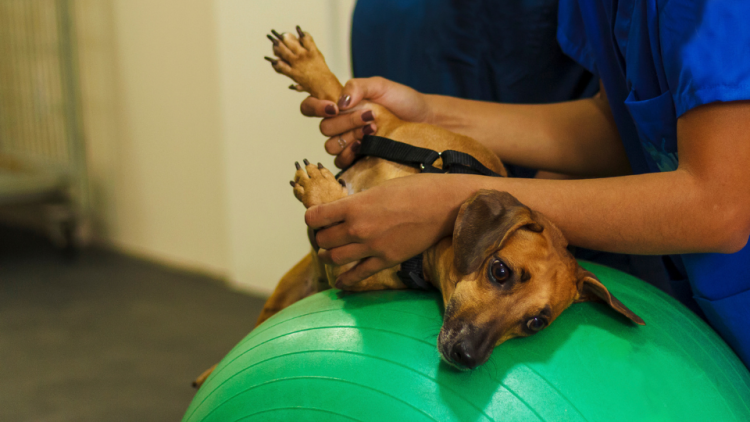Whether your dog has an acute injury or suffers from a chronic condition like arthritis, seeing them in pain can be heartbreaking. It’s always best to consult your vet for a prescription, but in some situations, you might try searching for something they can take to alleviate their discomfort.
So, how do you know which pain relievers are safe for dogs? This post will help you navigate dog pain relief options so you can make a well-informed decision on behalf of your best friend.
Table of Contents:
- Signs of pain in dogs
- What can I give my dog for pain?
- Can dogs take pain medication for humans?
- Natural pain relief for dogs
- What to give puppies for pain relief
- Key Takeaways
Pro Tip: Pet insurance can help provide dog owners with the peace of mind knowing that they can afford the best treatment for their beloved pets if they suffer from painful condition or medical emergency.
Signs of pain in dogs
Dogs have a canny ability to hide their pain. Sadly, by the time a dog starts showing symptoms of pain, whatever condition they’re suffering from might have relatively progressed. For this reason, it's crucial to take your pet to the vet at any sign of distress.
Some signs of dogs in pain include:
- Limping
- Excessive grooming
- Aggressive behavior
- Decreased energy levels
- Lack of appetite
- Increased sleep
- Reluctance to jump or climb stairs
- Swelling or inflammation
- Lowered tail
- Vocalizations (yelping, whining, groaning, or howling)
What can I give my dog for pain relief?
NSAIDs
Nonsteroidal anti-inflammatory drugs (NSAIDs) can help reduce various types of pain in dogs, including joint pain, muscle tenderness, chronic stiffness, arthritis, temporary swelling, and post-surgical incisions. There are NSAIDs available specifically for canines, including Carprofen Meloxicam, Deracoxib, and Firocoxib.
NSAIDs are typically considered to be safe for dogs and have minimal side effects. In some cases, however, they can cause digestive issues or kidney and liver dysfunction. Signs of adverse reaction to dog pain meds include decreased appetite, changes in behavior, vomiting, diarrhea, tarry stools, and skin redness or scabs. If you notice any of these symptoms after you’ve given your pooch pain killers, stop giving the drug and contact your veterinarian.
Other medications
NSAIDs are usually the first choice for relieving pain in pets, but if your dog needs more options, your veterinarian might recommend Tramadol or Gabapentin.
Tramadol works partly like a painkiller and partly like a mild opioid. Veterinarians often prescribe it to senior dogs who suffer from constant discomfort. Side effects that might occur include vomiting, dizziness, and stomach upset.
Gabapentin is used to treat pain from damaged nerves in both dogs and humans. The drug might make your pet sleepy, but only for the first couple of days. In some cases, vets prescribe Gabapentin in combination with other medications for dogs.

Can dogs take pain medication for humans?
You should NEVER give a dog human-grade NSAID drugs such as ibuprofen. Over-the-counter (OTC) pain meds and other human drugs can be dangerous and even fatal for dogs.
If given to dogs, human pain meds cause a number of complications including:
- Diarrhea and vomiting
- Gastrointestinal bleeding
- Liver and kidney damage
- Ulcers
- Loss of appetite
- Holes in the stomach lining
If your dog is showing these or other signs after ingesting a human medication, call your vet as soon as possible. Without adequate treatment, your pet might die.
Some dogs are especially sensitive to human NSAIDs and can develop serious side effects even if they’re given a very small dosage. In addition, using human NSAIDs with other medications (like corticosteroids), or giving them to dogs who suffer from certain health conditions (for instance, kidney failure or gastrointestinal disease) can make the use of these drugs even riskier than usual.
What about aspirin?
Aspirin is another common NSAID used by humans. Your vet might approve aspirin or baby aspirin for your furry friend for a short while, usually in the case of an injury. You should always call your vet to ask about aspirin BEFORE administering it, even for a short time.
If given for a longer period of time, aspirin can cause a number of adverse side effects in dogs, including gastrointestinal bleeding and stomach ulcers. Before giving aspirin to your pet, consult your vet about the frequency and dosage.
Can you give Tylenol to dogs?
Tylenol (acetaminophen) isn’t an NSAID, but it's still dangerous for dogs. When canines ingest large amounts of acetaminophen, it can impede kidney function, destroy liver cells, and cause poor oxygen delivery throughout the body.
Natural pain relief for dogs
Prescription pain relievers aren’t the only way to provide your pet with relief. Here are some alternative options to consider:
Physical therapy
One of the best natural pain relievers for your canine companion, especially if they have hip dysplasia or arthritis, is physical therapy and exercise. Exercise keeps the joint functioning and helps prevent muscle loss, which places more stress on joints. Their pain will only worsen if they lie around all the time.

Non-weight-bearing exercises like swimming are a great way to maintain muscle tone when dealing with other painful issues, such as recovering from orthopedic surgery or degenerative bone disease.
Other physical therapy techniques, like full body massage, acupuncture, and laser treatment can also be helpful.
Supplements
Supplements, such as chondroitin and glucosamine, have been shown to prevent and help treat degenerative joint conditions like osteoarthritis and are quite popular alternative treatments.
Both of these supplements can be administered in your dog’s food or in capsule form. Some commercial dog foods already contain glucosamine and chondroitin, so be sure to speak with your vet before adding these or any other supplements to your pet’s diet.
Weight loss and dietary modification
Chronic inflammatory conditions like osteoarthritis tend to respond well to dietary modifications, whereas weight loss can help slow the process of cartilage degeneration.
Simply put, the less weight your pet bears on their joints, the less of a beating the cartilage will take.
Talk to your vet to determine which medication or treatment is right for your pet.
Pro Tip: Keeping our dogs healthy and free from pain is our responsibility as pet parents. This involves providing them with preventative health care, signing them up for a pet insurance plan, and seeking medical treatment in a timely manner when they become injured or sick.
What to give puppies for pain relief
In small puppies, crying is a way of communicating pain and discomfort. Even though, in general, the medications that are safe for adult dogs are also safe for puppies, the smart choice is to get your puppy checked by a vet.
Your vet will check for any abnormalities or congenital disabilities, then inspect the puppy for a bloated stomach and sources of discomfort. The vet will prescribe the best therapy, determine a dosage suitable for a small puppy, and explain the best way to administer the medication.
Key Takeaways
- There are several meds for dogs designed specifically for pain control and these are much safer and more effective than human drugs.
- Giving dogs non-prescribed drugs can result in accidental poisoning and even cause kidney failure.
- It’s very important not to administer pain relief medication to your canine friend without first talking to your veterinarian.
- If your dog shows signs that they’re in pain, they should be examined by a vet. The vet will determine what is causing the pain and prescribe adequate therapy.
- If you are interested in trying natural pain relief options, ask your vet for advice on which methods are best for your dog’s condition.
